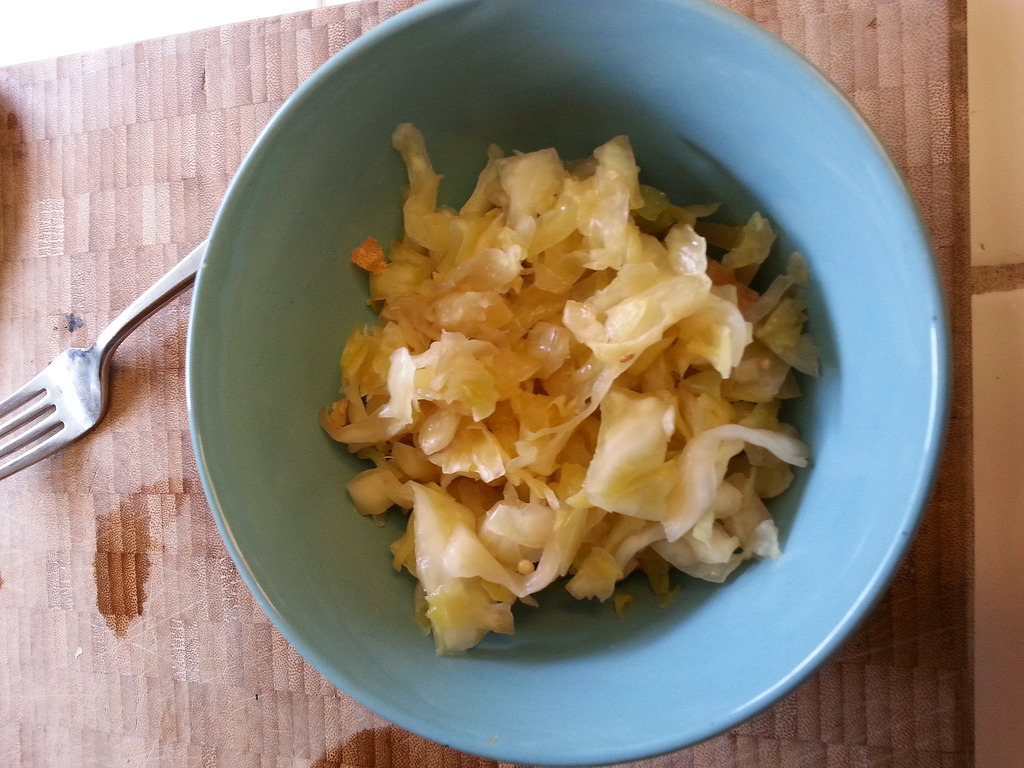I can't believe I never did a sauerkraut post. Really? Anyway, with my parents in town again for the winter, I've decided to make a new batch of sauerkraut. Lucky you.
Making sauerkraut is about as simple and foolproof as kitchen fermentation gets. You need a head of cabbage, shredded, some kosher salt, a clean dowel or some other implement for pounding the kraut into the fermentation vessel, and a fermentation vessel. I'm using a quart mason jar.

Step one: Rinse the cabbage off, remove any wimpy outer leaves, quarter and core. Shred. I use a chef's knife and cut fairly fine.
Step two: Layer cabbage in a big bowl with sprinklings of salt. You need maybe a tablespoon of kosher salt. Maybe. Don't overdo the salt. Mix with your hands so that the salt is well dispersed. Let everything sit for ten minutes or so to start to wilt, then massage the kraut with your hands. Brine will start to develop in the bowl.
Step three: Stuff the kraut into your fermentation vessel a handful at a time. Sprinkle any flavoring agents in with each layer and tamp down aggressively to compact the kraut and develop the brine. You should have a healthy layer of brine rising above the level of the veg by the time you've mostly filled the container. A medium head of cabbage will yield slightly more kraut than will fit into a quart mason jar.

Flavoring agents are flexible. Traditional would be just caraway seed. The batch I made today was half caraway and half dill seed, but as you can see from this picture, the prior batch was a bit more diverse (and turned out awesome).
My device of choice is the Kraut Source system on top of a conventional, wide-mouthed mason jar. Works great to contain the fermenting veg below the level of the brine to keep things nicely anaerobic. But you can get by just fine without the fancy contraption with just a ceramic weight or a clean rock or any number of other strategies.

Let the kraut ferment for a week or longer. I check the moat on my contraption daily to make sure it doesn't go dry. Otherwise, when the cap burps it clinks. If you are just using a standard mason lid, you need to leave it loose so that excess carbon dioxide can escape.
Finally, of course, you gotta eat.



Trust me on this, kids. Fermenting is easy, and this will be the best sauerkraut you've ever had (unless your grandma made sauerkraut...). About the only thing that can go wrong is that you use too much salt and will need/want to rinse before eating. If the kraut is really salty, you can always drain off some of the brine and replace it with an equal amount of (boiled, cooled) plain water.
Yeah, I'm going to be making this in the next couple weeks, for sure.
I need to make this at some point, looks great!
I almost bought one of those Kraut Source contraptions, but I'm cheap. Does it make enough of a difference to be worth it?
It is certainly convenient and simple to use. Certainly not necessary, but when I've made pickles with it, I have much better success in keeping down mold growth than when I've not used it.
I think that endorsement means adding it to my Christmas list. Thanks.
Fermentation! Wooo!
I, also, totally need to do this.